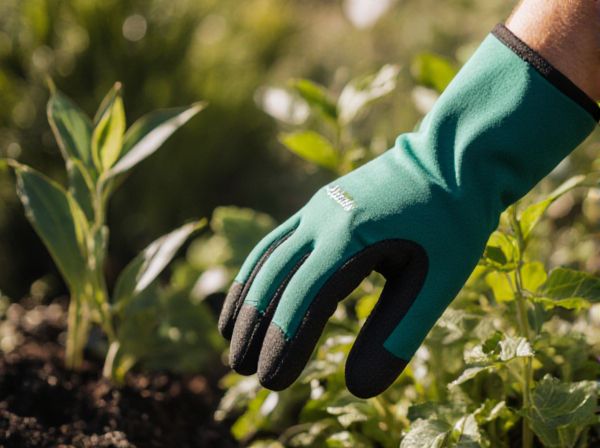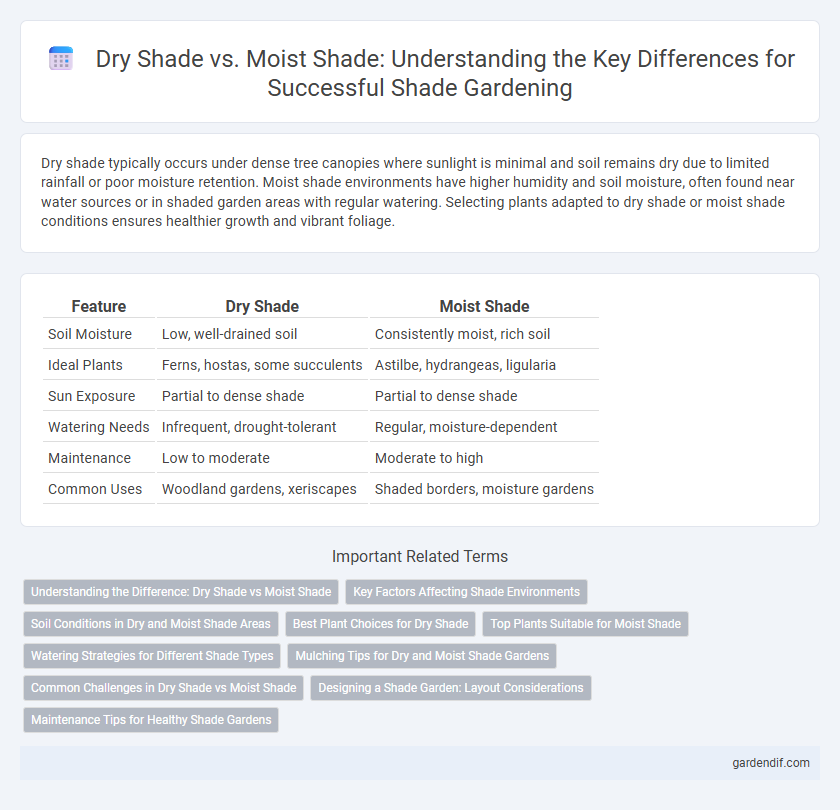
Dry Shade vs Moist Shade Illustration
Dry shade typically occurs under dense tree canopies where sunlight is minimal and soil remains dry due to limited rainfall or poor moisture retention. Moist shade environments have higher humidity and soil moisture, often found near water sources or in shaded garden areas with regular watering. Selecting plants adapted to dry shade or moist shade conditions ensures healthier growth and vibrant foliage.
Table of Comparison
| Feature | Dry Shade | Moist Shade |
|---|---|---|
| Soil Moisture | Low, well-drained soil | Consistently moist, rich soil |
| Ideal Plants | Ferns, hostas, some succulents | Astilbe, hydrangeas, ligularia |
| Sun Exposure | Partial to dense shade | Partial to dense shade |
| Watering Needs | Infrequent, drought-tolerant | Regular, moisture-dependent |
| Maintenance | Low to moderate | Moderate to high |
| Common Uses | Woodland gardens, xeriscapes | Shaded borders, moisture gardens |
Understanding the Difference: Dry Shade vs Moist Shade
Dry shade refers to areas with limited moisture where sunlight is blocked by structures or trees, often resulting in drier soil conditions unsuitable for moisture-loving plants. Moist shade occurs in shaded areas with consistently damp soil, typically found near water bodies or places with regular irrigation, supporting lush, shade-tolerant vegetation. Understanding the differences between dry shade and moist shade is essential for selecting appropriate plants and optimizing landscaping success in shaded environments.
Key Factors Affecting Shade Environments
Dry shade environments are characterized by limited moisture availability, often resulting from fast-draining soils and minimal rainfall, which affect plant selection and growth. In contrast, moist shade areas retain higher soil moisture levels due to dense canopy cover and lower evaporation rates, promoting different vegetation types adapted to damp conditions. Key factors influencing these shade environments include soil texture, canopy density, and microclimate variations, all of which dictate moisture retention and light penetration essential for plant health.
Soil Conditions in Dry and Moist Shade Areas
Soil conditions in dry shade areas are typically well-drained, sandy, or rocky with low organic matter, requiring plants to be drought-tolerant and adapted to nutrient-poor environments. Moist shade soils retain higher moisture levels, often rich in organic matter and nutrients, supporting a wider variety of shade-loving plants that thrive in consistently damp conditions. Understanding these soil differences is crucial for selecting appropriate vegetation and ensuring healthy plant growth in varied shaded environments.
Best Plant Choices for Dry Shade
Dry shade environments, characterized by limited moisture and low sunlight, require plants that are drought-tolerant and shade-loving. Ideal plant choices for dry shade include native ferns like the Christmas fern (Polystichum acrostichoides), epimedium varieties, and woodland perennials such as hostas and hellebores that thrive without frequent watering. Selecting deep-rooted species like Japanese painted fern (Athyrium niponicum) ensures resilience and healthy growth in dry shade conditions.
Top Plants Suitable for Moist Shade
Top plants suitable for moist shade include hostas, ferns, astilbes, and heucheras, which thrive in damp, shaded environments. These plants tolerate consistently moist soil and help prevent erosion while adding texture and color to shaded garden areas. Selecting species like Japanese painted fern and primrose enhances biodiversity and supports moisture retention in landscapes.
Watering Strategies for Different Shade Types
Dry shade requires infrequent, deep watering to encourage drought-tolerant root systems, while moist shade benefits from consistent moisture without waterlogging the soil. Mulching helps retain soil moisture in both conditions but should be adjusted to prevent fungal issues in moist shade environments. Selecting drought-resistant plants is crucial for dry shade, whereas moisture-loving species thrive better in consistently damp shaded areas.
Mulching Tips for Dry and Moist Shade Gardens
Mulching in dry shade gardens requires using organic materials like wood chips or bark to retain soil moisture and reduce evaporation, while ensuring mulch is kept a few inches away from plant stems to prevent rot. In moist shade gardens, applying a thinner layer of mulch such as compost or leaf mold improves soil aeration and prevents excess moisture buildup that can lead to fungal diseases. Proper mulching tailored to shade conditions helps maintain healthy root systems and optimizes water retention for both dry and moist environments.
Common Challenges in Dry Shade vs Moist Shade
Dry shade commonly presents challenges such as poor soil moisture retention, leading to water stress in plants and limited nutrient availability. In contrast, moist shade often results in excessive soil moisture, causing root rot and fungal diseases due to poor drainage. Both environments require specific plant selections and management practices to address these moisture-related issues effectively.
Designing a Shade Garden: Layout Considerations
Designing a shade garden requires careful consideration of dry shade versus moist shade conditions to ensure plant selection aligns with soil moisture levels. Dry shade areas often have well-drained, compacted soil beneath dense tree canopies, favoring drought-tolerant species like ferns and hostas. Moist shade environments support plants needing consistent moisture, such as astilbes and ligularia, necessitating layout plans that accommodate water-retentive soil and prevent waterlogging.
Maintenance Tips for Healthy Shade Gardens
Dry shade requires drought-tolerant plants like ferns and hostas, with maintenance involving minimal watering and mulching to retain soil moisture. Moist shade supports species such as astilbe and ligularia, needing consistent watering and organic-rich soil to prevent dryness. Regular pruning and monitoring for pests ensure healthy growth in both dry and moist shade garden environments.
Dry Shade vs Moist Shade Infographic

 gardendif.com
gardendif.com